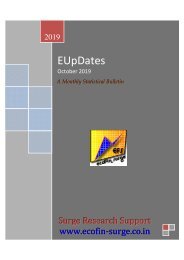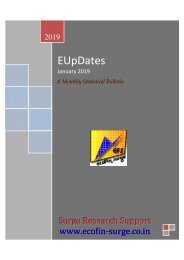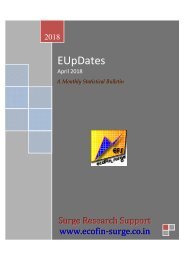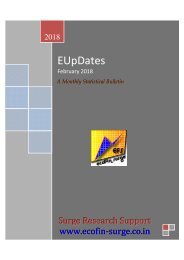EUpDates July 2021
A monthly statistical e-bulletin of the latest economic and financial market indicators. Quick Review of the Economy and over 30 Tables and some Charts.
A monthly statistical e-bulletin of the latest economic and financial market indicators. Quick Review of the Economy and over 30 Tables and some Charts.
Create successful ePaper yourself
Turn your PDF publications into a flip-book with our unique Google optimized e-Paper software.
A QUICK REVIEW of the ECONOMY
GLOBAL ECONOMIC GROWTH is projected at 6.0% in 2021 by the IMF. Prospects for EMDEs have been marked down for
2021, especially for Emerging Asia. By contrast, the forecast for AEs is revised up reflecting progress in vaccinations and
changes in policy support. The J.P.Morgan Global Composite Output Index slipped to a four-month low of 55.7 in July, down
from 56.6 in June, remaining above its long-run average of 53.4. National PMIs indicated that growth was quickest in Germany,
Spain and the US. Rates of expansion in China, Brazil and Russia were all below the global average. Contractions were signalled
in India, Japan and Australia. Demand in several domestic markets, international trade flows, and job creation expanded but
slowed to near four month lows in July. Inflation continues to ratchet up across the world. Recent price pressures for the most
part reflect unusual pandemic-related developments and transitory supply-demand mismatches. Despite near-term supply
disruptions, global trade volumes are projected to expand 9.7% in 2021. The IMF's estimates showed that the combined
current account deficits and surpluses widened to 3.2% of global economic output in 2020 from 2.8% in 2019 on massive
deficit aid spending in AEs combined with wider trade gaps for medical supplies and plunging demand for oil and travel.
Global financing conditions are still favorable across all asset classes, according to S&P Global. Bond issuance remained robust
in the second quarter, though global nonfinancial issuance was unable to keep up with the extraordinary $1.1 trillion recorded
in the second quarter of 2020. Investors' hunt for yield have pushed speculative-grade bond, leveraged loan, and collateralized
obligation totals to multiyear and in some cases record-breaking first-half totals in 2021.
The UNITED STATES economy grew at an annualised rate of 6.5% in the second quarter, slower than expected with a rise in
Covid cases and a significant easing in both monetary and fiscal stimulus. Consumer spending was strong in the second
quarter, rising by 11.8%. Biden's administration signed $1.9trillion (£1.4trillion) in pandemic relief in March, sending onetime
$1,400 stimulus cheques to eligible households, as well as extending pandemic-related unemployment benefits through
to early September. US, CPI inflation in June recorded largest monthly momentum in about 13 years and surged to 5.4%
pushed up by food among others. The Fed’s preferred measures of inflation, the y-o-y changes in the personal consumption
expenditure (PCE) index and PCE excluding food and energy, at 3.9% and 3.4%, respectively, in May continued to be at multidecade
highs The US economy added more jobs than expected in July as employment rose by 943,000. There were gains in
sectors including leisure and hospitality, education and professional services, however, before the spread of the new variant of
covid.
EURO AREA GDP grew by 2% in the second quarter, taking the region out of a double-dip recession, with growth in all the
individual national economies. The euro area's two largest economies saw more moderate growth, 1.5% in Germany and 0.9%
in France. household spending made an important contribution in France, Germany and especially in Spain. In France there
was a surge in the hotel and restaurant trade of 29%. German auto companies in particular have shown strong profits even as
global auto markets recover. Euro area's unemployment was at 7.7% in June, down from 8.0% in May. Inflation rose to 2.2% in
July from 1.9% in June. The euro area economy has been sustained by government spending on pandemic relief including
subsidies for companies that keep furloughed workers on the payroll. The European Central Bank is adding monetary support
by keeping interest rate benchmarks at record lows and by purchasing 1.85 trillion euros in government and corporate bonds
through at least March 2022.
UNITED KINGDOM economic recovery slowed sharply in July as businesses struggled with weaker consumer demand and
wide-ranging shortages of staff and raw materials. Reflecting the impact on the economy of higher Covid infection rates and
global supply chain disruption, the IHS Markit/Cips PMI, a closely watched gauge of private sector activity, dropped from 62.2
to 57.7 in July, with falls in the manufacturing and services sectors. UK inflation jumped to 2.5% in June, the highest level in
almost three years, with increases in the price of food, secondhand cars, clothing and footwear, and petrol and diesel. The
number of workers on furlough has steadily fallen, to about 1.5 million by mid July, compared with 5.1 million during the
January lockdown. Having dropped slightly in recent months, the unemployment rate remained unchanged at 4.8% in the
three months to May. UK’s budget deficit was at £22.8billion in June, down by £5.5billion as the reopening of the economy
fuelled a rise in tax receipts.
JAPAN recorded economic contraction by an annualised 3.9% in the first quarter marked the first fall in three quarters, as
curbs on activity to combat the pandemic hit consumption. Private consumption, which makes up more than half of gross
domestic product, dropped 1.5% mom. Inflation-adjusted wages, a barometer of household purchasing power, rose 2.1% yoy
in April, as rebounds in overtime pay and compensation for part-time workers helped lift wages. However, a spike in Delta
variant cases that has forced Japan to expand state of emergency curbs during the Olympic Games. Household spending fell
5.1% yoy in June, even as wages fell 0.1%. Japan's exports jumped 48.6% yoy in June led by U.S. demand for cars and Chinabound
shipments of chip-making equipment, supporting hopes for an export-led recovery in the world's third-largest
economy.
CHINA has led the global recovery from the Covid-19 pandemic, but there are signs underlying growth momentum is
softening. China's factory activity expanded in July at the slowest pace in 17 months as higher raw material costs, equipment
maintenance, global supply-chain bottlenecks and extreme weather weighed on business activity, adding to concerns about a
slowdown China's services sector has been slower to recover from the pandemic than manufacturing, but has been helped by
a gradual improvement in consumption in recent months. The Caixin/Markit services PMI unexpectedly rose to 54.9 in July,
up from 50.3 the previous month. PBOC in mid-July lowered the reserve requirement for banks, releasing around 1 trillion
yuan ($154 billion) in long-term liquidity. China runs a trade deficit with many countries in the region, underscoring its
importance as a source of final demand. Asian nations relied on exports to China to support growth throughout the pandemic
while domestic activity remained sluggish.
E-UpDates July 2021
2
Surge Research Support










